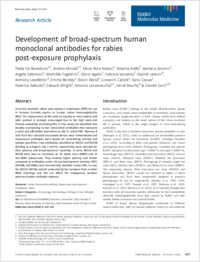Development of broad‐spectrum human monoclonal antibodies for rabies post‐exposure prophylaxis
- De Benedictis, Paola FAO and National Reference Centre for Rabies, National Reference Centre and OIE Collaborating Centre for Diseases at the Animal‐Human Interface, Istituto Zooprofilattico Sperimentale delle Venezie, Legnaro, Padua, Italy
- Minola, Andrea Humabs BioMed SA, Bellinzona, Switzerland
- Rota Nodari, Elena FAO and National Reference Centre for Rabies, National Reference Centre and OIE Collaborating Centre for Diseases at the Animal‐Human Interface, Istituto Zooprofilattico Sperimentale delle Venezie, Legnaro, Padua, Italy
- Aiello, Roberta FAO and National Reference Centre for Rabies, National Reference Centre and OIE Collaborating Centre for Diseases at the Animal‐Human Interface, Istituto Zooprofilattico Sperimentale delle Venezie, Legnaro, Padua, Italy
- Zecchin, Barbara FAO and National Reference Centre for Rabies, National Reference Centre and OIE Collaborating Centre for Diseases at the Animal‐Human Interface, Istituto Zooprofilattico Sperimentale delle Venezie, Legnaro, Padua, Italy
- Salomoni, Angela FAO and National Reference Centre for Rabies, National Reference Centre and OIE Collaborating Centre for Diseases at the Animal‐Human Interface, Istituto Zooprofilattico Sperimentale delle Venezie, Legnaro, Padua, Italy
- Foglierini, Mathilde Institute for Research in Biomedicine (IRB), Faculty of Biomedical Sciences, Università della Svizzera italiana, Switzerland
- Agatic, Gloria Humabs BioMed SA, Bellinzona, Switzerland
- Vanzetta, Fabrizia Humabs BioMed SA, Bellinzona, Switzerland
- Lavenir, Rachel Institut Pasteur, Unit of Lyssavirus Dynamics and Host Adaptation, National Reference Centre for Rabies, World Health Organization Collaborating Centre for Reference and Research on Rabies, Paris Cedex 15, France
- Lepelletier, Anthony Institut Pasteur, Unit of Lyssavirus Dynamics and Host Adaptation, National Reference Centre for Rabies, World Health Organization Collaborating Centre for Reference and Research on Rabies, Paris Cedex 15, France
- Bentley, Emma Viral Pseudotype Unit, Faculty of Science and Technology, University of Westminster, London, UK
- Weiss, Robin Division of Infection and Immunity, University College London, London, UK
- Cattoli, Giovanni FAO and National Reference Centre for Rabies, National Reference Centre and OIE Collaborating Centre for Diseases at the Animal‐Human Interface, Istituto Zooprofilattico Sperimentale delle Venezie, Legnaro, Padua, Italy
- Capua, Ilaria FAO and National Reference Centre for Rabies, National Reference Centre and OIE Collaborating Centre for Diseases at the Animal‐Human Interface, Istituto Zooprofilattico Sperimentale delle Venezie, Legnaro, Padua, Italy
- Sallusto, Federica Institute for Research in Biomedicine (IRB), Faculty of Biomedical Sciences, Università della Svizzera italiana, Switzerland
- Wright, Edward Viral Pseudotype Unit, Faculty of Science and Technology, University of Westminster, London, UK
- Lanzavecchia, Antonio Institute for Research in Biomedicine (IRB), Faculty of Biomedical Sciences, Università della Svizzera italiana, Switzerland - Institute of Microbiology, ETH Zurich, Zurich, Switzerland
- Bourhy, Hervé Institut Pasteur, Unit of Lyssavirus Dynamics and Host Adaptation, National Reference Centre for Rabies, World Health Organization Collaborating Centre for Reference and Research on Rabies, Paris Cedex 15, France
- Corti, Davide Humabs BioMed SA, Bellinzona, Switzerland - Institute for Research in Biomedicine (IRB), Faculty of Biomedical Sciences, Università della Svizzera italiana, Switzerland
-
18.03.2016
Published in:
- EMBO molecular medicine. - 2016, vol. 8, no. 4, p. 407-421
English
Currently available rabies post‐exposure prophylaxis (PEP) for use in humans includes equine or human rabies immunoglobulins (RIG). The replacement of RIG with an equally or more potent and safer product is strongly encouraged due to the high costs and limited availability of existing RIG. In this study, we identified two broadly neutralizing human monoclonal antibodies that represent a valid and affordable alternative to RIG in rabies PEP. Memory B cells from four selected vaccinated donors were immortalized and monoclonal antibodies were tested for neutralizing activity and epitope specificity. Two antibodies, identified as RVC20 and RVC58 (binding to antigenic site I and III, respectively), were selected for their potency and broad‐spectrum reactivity. In vitro, RVC20 and RVC58 were able to neutralize all 35 rabies virus (RABV) and 25 non‐RABV lyssaviruses. They showed higher potency and breath compared to antibodies under clinical development (namely CR57, CR4098, and RAB1) and commercially available human RIG. In vivo, the RVC20–RVC58 cocktail protected Syrian hamsters from a lethal RABV challenge and did not affect the endogenous hamster post‐vaccination antibody response.
- Language
-
- English
- Classification
- Medicine
- License
- Open access status
- gold
- Identifiers
-
- RERO DOC 326885
- DOI 10.15252/emmm.201505986
- ARK ark:/12658/srd1319138
- Persistent URL
- https://n2t.net/ark:/12658/srd1319138
Statistics
Document views: 169
File downloads:
- Texte intégral: 219
